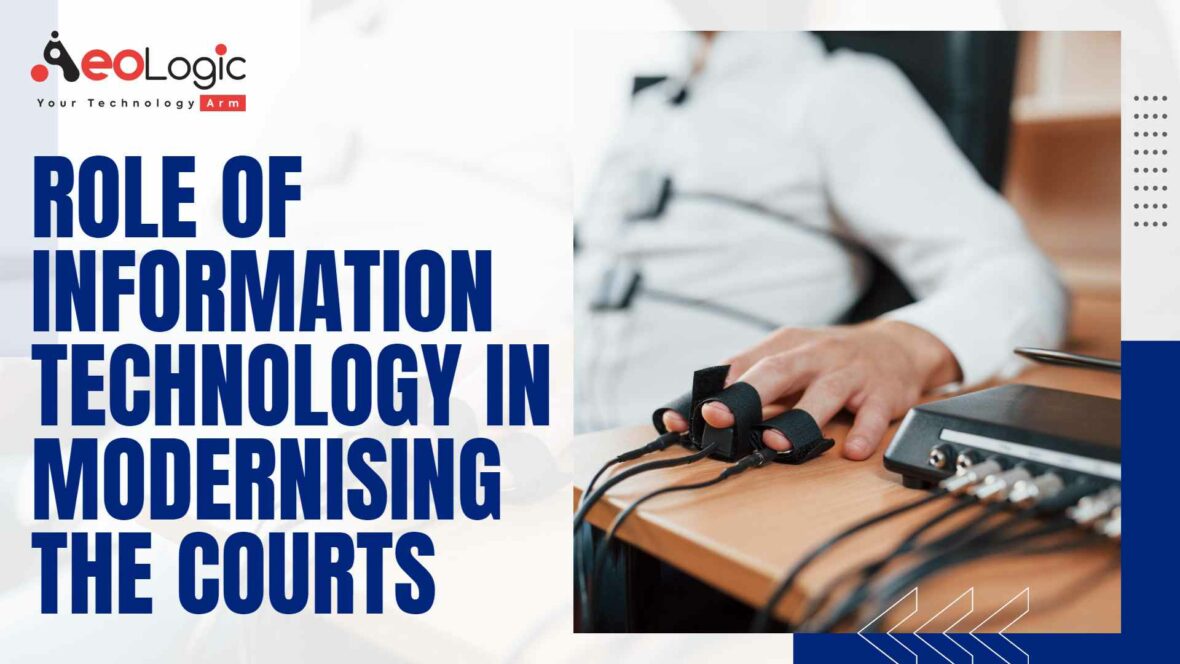As the popular phrase goes: necessity is the mother of invention, and the COVID-19 pandemic is a major example of this. The pandemic is forcing India to adapt to technology it had long kept ignoring. Even the judicial system observed the adoption of technology, which is typically a face-to-face job. However, it is now, more than ever, that there is a higher need to focus and rely on the role of IT in modernising court. The role of IT in modernising court is to make sure that the judicial system does not get hampered. Because of anything, not even the next big pandemic. The judicial system has come a long way, previously it was believed that in order to provide justice, physically being present in the court was a requirement. However, now, justice can be delivered with the facilitation of computers, the internet, and IT.
Also read: Importance of Information Technology in Today’s World
The Role of IT in Modernising Courts
The benefits of information technology are endless. Following are some of the benefits of IT in modernising courts:
Cost-Effectiveness-
Video conferencing between lawyers and court authorities is reducing the cost of travelling and accommodation of both the court authorities such as clerks, judges, lawyers, etc.
Automation-
The role of IT in modernising courts is enabling organizations to become automated. This is allowing users to access information or website 24 hours a day and seven days a week. Therefore, in the context of Indian courts, lawyers are able to file their cases, receive notices, submit documents, receive the next dates for the hearing, and access the e-library. All while sitting from the comfort of their home, at any time of the month, week, or day.
Bridging the Culture Divide-
Increasing access to the role of IT in modernising courts is helping in decreasing the cultural divide. All these by enabling individuals of other cultures to communicate with each other and exchange their ideas and views. Furthermore, judges and lawyers will be communicating their ideas and thoughts with each other on the platform, regardless of which part of India they are from or which culture they belong from. Therefore, this will be helping in bridging the gap between different jurisdictions of court.
Creating New Jobs-
Another major role of IT in modernising courts is to create more employment opportunities across the globe. Adoption of IT in Indian Courts will need the employment of skilled professionals for maintaining the servers. Hence, this will drive the creation of more jobs and will aid in reducing the unemployment problem in India.
More Resources for Judges and Lawyers-
The inclusion of IT will be helping judges and lawyers for accessing the e-library at any time of the day, week, or month. In turn, this will support them to prepare for cases or judgments while not requiring them to be physically present in the court’s library room.

Witnessing Protection-
Many witnesses who are not able to approach the court to deliver their statements because of danger or threats to life can simply provide their statements. With the role of IT in modernising courts is because they wouldn’t have to be physically present in the court.
Challenges With the Adoption of IT in Modernising Court
Incorporation of E-Courts-
The problem with implementing electronic courts in India is that it is still an incomplete vision. Due to the fact that many legal professionals in India are still not accustomed to the electronic mode of communication. And there is an absence of technical knowledge among several practicing legal professionals.
Cost Intensive-
Setting up electronic courts is an expensive ordeal. Also, it would be requiring a large amount of funding. Several courts in smaller jurisdictions might not be having access to so huge amount of money. Which perhaps will be slowing down the nationalized adoption of electronic courts in India.
Risk of Getting Hacked-
With anything being done on the internet, there is always a risk associated with it being hacked or being a victim of cyberattacks. On the other hand, courts require to set up proper cybersecurity prevention methods for making sure that they don’t get hacked or that confidential information is not lost.

Lack of Technical Knowhow-
Court clerks of lower courts are not well prepared with technical know-how for managing records or tracking evidence effectively or efficiently. In order to make it easily accessible to the tribunal, litigant, and court.
Inadequate Infrastructure-
Courts in rural areas are not having the proper infrastructure to successfully set up an e-court. That is, because of the lack of static electricity or the internet.
Also read: The Importance of Information Technology in Business Today
Conclusion
While technology is driving a lot of things in today’s day and age. Though tricky, the role of IT in modernising courts can be really useful for the smooth and efficient functioning of courts. However, the role of IT in modernising courts will lead to the development of two kinds of courts. Since the presence of physical courts or courtrooms cannot go out of existence overnight. Therefore, either of the two can be applied, either courtrooms can be used for dealing with long cases which have a very long duration of time or they can deal with small and petty cases which can be settled within a few hearings.
Feel free to connect with us to learn more about the implications of information technology!
FAQs
How technology can transform the courtroom?
Courtroom technology can present new ways to show evidence. While there is no set standard, however, for technology in the courtroom, the utilization of interactive displays, and video testimony. And the use of multiple screens for showing documents, are all ways in which technology can improve the courtroom experience.
How technology is helping in the administration of justice?
Firstly, it can offer management and operational support, allowing courts to deal better with the increased size and complexity of their caseloads.






